Maria Leopoldina of Austria
Dona Maria Leopoldina of Austria (22 January 1797 – 11 December 1826) was Empress of Brazil as the wife of Emperor Dom Pedro I. She was Queen of Portugal during her husband's brief reign as King Dom Pedro IV.
| Maria Leopoldina of Austria | |||||
|---|---|---|---|---|---|
 Portrait by Joseph Kreutzinger, c. 1815 | |||||
| Empress consort of Brazil | |||||
| Tenure | 12 October 1822 – 11 December 1826 | ||||
| Queen consort of Portugal | |||||
| Tenure | 10 March 1826 – 2 May 1826 | ||||
| Born | 22 January 1797 Vienna, Austria, Holy Roman Empire | ||||
| Died | 11 December 1826 (aged 29) São Cristóvão Palace, Rio de Janeiro, Empire of Brazil | ||||
| Burial | 1954 | ||||
| Spouse | |||||
| Issue Detail | |||||
| |||||
| House | Habsburg-Lorraine | ||||
| Father | Francis II, Holy Roman Emperor | ||||
| Mother | Maria Theresa of Naples and Sicily | ||||
| Religion | Roman Catholicism | ||||
| Signature | |||||
She was born Caroline Josepha Leopoldine Franziska Ferdinanda of Habsburg-Lorraine in Vienna, Austria, the daughter of Holy Roman Emperor Francis II, and his second wife, Maria Theresa of Naples and Sicily. Among her many siblings were Emperor Ferdinand I of Austria and Marie Louise, Duchess of Parma, the wife of Napoleon Bonaparte.
Early life

Leopoldina was born on 22 January 1797 in Vienna, Archduchy of Austria. She was given the name Caroline Josepha Leopoldine Franziska Ferdinanda,[1] according to her biographer Carlos H. Oberacker, and confirmed by Bettina Kann in her work "Cartas de uma Imperatriz", who mentioned a contemporary source: the Austrian newspaper Wiener Zeitung of 25 January 1797, who gave the news of the birth of the Archduchess three days before with her full name. According to Oberacker, the name "Maria" wasn't present in the preserved baptismal record of the Archduchess,[2] and she began to use it only during her journey to Brazil, where she began to be named Maria Leopoldina in all documents, including the Constitutional oath of 1822. According to another theory presented by Oberacker, the Archduchess probably began to use the name "Maria" due to her great devotion to the Virgin Mary and because all her sisters-in-law used this name.
She was raised in accordance with the educational principles laid down by her grandfather, Emperor Leopold II. Among these was the habit of exercising her handwriting by writing the following text:[3]
Do not oppress the poor. Be charitable. Do not complain about what God has given you, but improve your habits. We must strive earnestly to be good.
In addition, she and her sisters were taught to speak French and Latin. They were also educated in drawing, piano, riding and hunting.[3] Her mother died when she was ten years old and her father went on to remarry Maria Ludovika of Austria-Este. Her late mother was a soprano and Leopoldina had the chance of meeting Johann Wolfgang von Goethe in 1810 and 1812, when she went to Carlsbad with her stepmother.[3] Her passions included natural sciences, especially botany and mineralogy.[3] She was formed according to the three Habsburg principles: discipline, piety and a sense of duty.[3]
Although Maria Theresa of Naples and Sicily was her birth mother, Leopoldina always considered Empress Maria Ludovika, her stepmother, to be her mother and she grew up with Ludovika as her "spiritual mother".[3]
Marriage to Pedro
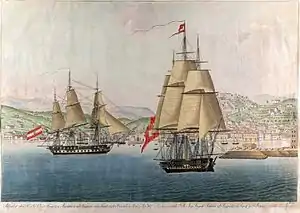
On 24 September 1816 it was announced by Leopoldina's father that Pedro of Braganza wished to take a Habsburg princess as his wife.[4] Klemens von Metternich suggested that it should be Leopoldina to go get married, as it was "her turn" to become a wife.[5] Two ships were prepared and in April 1817 scientists, painters, gardeners and a taxidermist, all with assistants, travelled to Rio de Janeiro ahead of Leopoldina, who, in the meantime, studied the history and geography of her future home and learned Portuguese. During these weeks Leopoldina compiled and wrote a vade mecum, a unique document the like of which has never been produced by any other Habsburg princess.[6]
On 13 May 1817 Leopoldina was married to Dom Pedro per procuram (by proxy) in Vienna. At the ceremony the bridegroom was represented by Leopoldina's uncle, Archduke Charles. Embarkation took place in Livorno on 13 August 1817 among much celebration, and after an adventure-filled voyage lasting 81 days, Leopoldina arrived in Rio de Janeiro on 5 November and finally met her husband.[7]
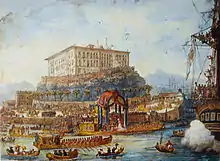
From a distance Pedro initially appeared to Leopoldina to be a perfect, well-educated gentleman, but the reality was very different. Dom Pedro was a year younger than Leopoldina and sadly rarely measured up to the descriptions given by the matchmakers. His temperament was impulsive and choleric, and his education but modest. Even spoken communication between the young married couple proved difficult, as Pedro spoke very little French and his Portuguese could only be described as vulgar.[7]
In keeping with Portuguese tradition, at the age of eighteen Pedro of Braganza not only had a string of amorous adventures behind him and was principally interested in horse racing and love affairs, but in 1817 (the year of his marriage to Leopoldina) he was living as if in wedlock with French dancer Noemie Thierry, who was finally removed from the court by his father a month after Leopoldina's arrival in Rio de Janeiro.[7]
The young married couple took up residence in six relatively small rooms in the Palace of São Cristóvão. The inner courtyard and path to the stables were unpaved and the tropical rainfall quickly turned everything to mud. There were insects everywhere, including in their clothing, for the uniforms and court regalia made of velvet and plush rotted and turned mouldy in the heat and humidity.[7]
Regent of Brazil
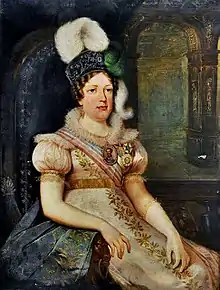
On 25 April 1821, the court returned to Portugal. A fleet of 11 ships took the king, the court, the royal house and the royal treasury, and only Prince Pedro remained in Brazil as regent of the country, with ample powers counterbalanced by a regency council. At first Pedro was incapable of dominating the chaos: the situation was dominated by the Portuguese troops, in anarchic conditions. The opposition between Portuguese and Brazilians became increasingly evident. It is clear from Leopoldina's correspondence that she has warmly espoused the cause of the Brazilian people and even desired the independence of the country and is therefore loved and venerated by the Brazilians.
According to Ezekiel Ramirez, below, the signs of a nascent Brazilian unit as an independent nation in the southern provinces were visible, but the north supported the Lisbon Cortes and called for regional independence. If the Prince Regent had left the country at that moment, Brazil would be lost to Portugal because the courts of Lisbon repeated the same error that led the Spanish courts to lose the colonies, seeking to establish direct contacts with each province in particular.
In Rio, thousands of signatures collected required the regents to remain in Brazil. "José Bonifácio de Andrada e Silva's courageous attitude toward Portuguese arrogance greatly encouraged the aspirations for unity that existed in the southern provinces, especially in São Paulo. A highly educated men led this movement." After Fico's day, 9 January 1822, a new ministry was organized under the leadership of José Bonifácio, "strictly monarchist", and the Prince Royal soon won the trust of the people. On 15 February 1822 the Portuguese troops left Rio, and their departure represented the dissolution of the ties between Brazil and the metropolis. The prince was triumphantly received in Minas Gerais.
When her husband, prince regent, traveled to São Paulo in August 1822 to pacify politics (which culminated in the proclamation of Brazil's independence in September), Leopoldina exercised the regency. Great was his influence in the process of independence. The Brazilians were already aware that Portugal intended to call Pedro back, relegating Brazil again to the status of a simple colony rather than a kingdom united to that of Portugal. There were fears that a civil war would separate the Province of São Paulo from the rest of Brazil. Pedro gave power to Leopoldina on 13 August 1822, appointing her head of the Council of State and Acting Princess Regent of the Kingdom of Brazil, with legal powers to govern the country during his absence and set out to appease São Paulo.
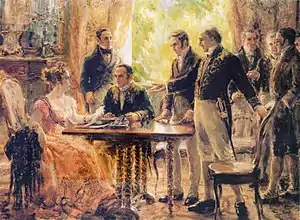
The Princess received news that Portugal was preparing action against Brazil and, without time to wait for Pedro's return, Leopoldina, advised by José Bonifácio de Andrada e Silva, and using his attributes as interim head of government, met in the morning of 2 September 1822, with the Council of State, signing the decree of Independence, declaring Brazil separate from Portugal. The Princess sends Pedro a letter, along with another letter from José Bonifácio, as well as comments from Portugal criticizing the actions of her husband and King João VI. It demands that Pedro proclaim the Independence of Brazil and, in the letter, warns: "The pommel is ripe, pick it up already, or it will rot."
The officer arrived at the prince on 7 September 1822. Leopoldina had also sent papers received from Lisbon, and comments from Antônio Carlos Ribeiro de Andrada, deputy to the courts, for which the Prince-Regent learned of criticism of him in the metropolis. The position of John VI and all his ministry, dominated by the courts, was difficult.
While awaiting the return of Pedro, Leopoldina, the interim ruler of an already independent Brazil, idealized the flag of Brazil, in which she mixed the green of the House of Braganza and the golden yellow of the House of Habsburg. Other authors say that Jean-Baptiste Debret, the French artist who designed what he saw in Brazil in the 1820s, was the author of the national pavilion that replaced that of the old Portuguese court, symbol of the oppression of the old regime. Debret is the design of the beautiful imperial flag, in collaboration with José Bonifácio de Andrada e Silva, in which the green rectangle of the Braganza represented the forests and the yellow rhombus, color of the Habsburg-Lorraine dynasty, represented the gold.
Empress of Brazil
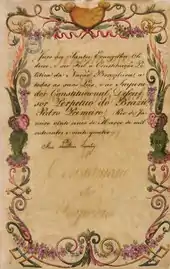
Maria Leopoldina became Brazil's first empress consort. She also played an important role in the process of issuing a Declaration of Independence. On 2 September 1822, a new decree with demands from Lisbon arrived in Rio de Janeiro, while Prince Pedro was in São Paulo. Leopoldina, advised by José Bonifácio, and using her power as Princess Regent, met on 2 September 1822 with the Council of Ministers. She decided to send her husband the news along with a letter advising him to declare Brazil's independence and warned him, "The fruit is ready, it's time to harvest." Prince Pedro declared the country's independence upon receiving the letter on 7 September 1822.
When his father, João VI, died on 10 March 1826, Pedro inherited the Portuguese throne as King Pedro IV, while remaining Emperor Pedro I of Brazil. Maria Leopoldina thus became both Empress consort of Brazil and Queen consort of Portugal. However, two months later, Pedro was forced to give up the Portuguese throne to their seven-year-old daughter Maria.
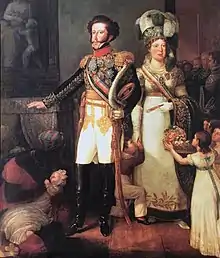
At the end of November 1826, Pedro traveled to Cisplatina (now Uruguay) to join his soldiers. To mark the occasion there was a large farewell reception on 20 November 1826, and Pedro demanded that both women, Maria Leopoldina and his official mistress Domitila de Castro, Marchioness of Santos, appear together before the ecclesiastical and diplomatic dignitaries and receive his kiss on the hand. With the fulfillment of this demand, Maria Leopoldina would have officially recognized her husband's mistress, and for this she refused to appear at the reception. This caused a bitter argument with Pedro, who departed with no resolution to the situation.[8]
Shortly after, Maria Leopoldina became ill, had spells of fever, became delirious at times, and then suffered a miscarriage on 2 December 1826. She died eight days later, on 11 December, five weeks before her thirtieth birthday. She was buried on 14 December 1826 in Rio de Janeiro, in the church of the Ajuda Convent.[8]
Contributions
Empress Leopoldina has always been interested in the sciences, and in 1818 João VI influenced by Leopoldina to create the Imperial Museum.[9] Just a few months after arriving in Brazil, the first Brazilian Natural History Museum, which promoted scientist to explore Brazil. In 1823, Leopoldina befriended Maria Graham, who was a British traveler who shared a common interest in the sciences.[9] This common interest allowed the women to stay close to each other up until Leopoldina's death. Leopoldina and Graham wanted to get information that they were not privileged to because they were living in a male dominated world.[9]
Titles and honours
| Styles of Empress Leopoldina of Brazil | |
|---|---|
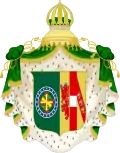 | |
| Reference style | Her Imperial Majesty |
| Spoken style | Your Imperial Majesty |
| Alternative style | Madam[10] |
Titles
- 22 January 1797 – 11 August 1804 Her Royal Highness Archduchess Leopoldina of Austria
- 11 August 1804 – 6 November 1817 Her Imperial and Royal Highness Archduchess and Princess Imperial Leopoldina of Austria, Princess Royal of Hungary and Bohemia
- 6 November 1817 – 12 October 1822 Her Imperial and Royal Highness The Princess Royal of the United Kingdom of Portugal, Brazil and the Algarves, Duchess of Braganza, Archduchess and Princess Imperial of Austria, Princess Royal of Hungary and Bohemia
- 12 October 1822 – 10 March 1826 Her Imperial Majesty The Empress of Brazil
- 10 March 1826 – 2 May 1826 Her Imperial and Most Faithful Majesty The Empress of Brazil, Queen of Portugal and the Algarves
- 2 May 1826 – 11 December 1826 Her Imperial Majesty The Empress of Brazil
Honours
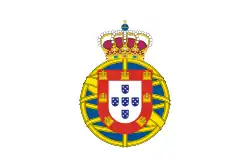 United Kingdom of Portugal, Brazil and the Algarves:
United Kingdom of Portugal, Brazil and the Algarves:
- Dame Grand Mistress of the Order of Saint Isabel
- Dame Grand Cross of the Order of the Immaculate Conception of Vila Viçosa
.svg.png.webp) Empire of Brazil:
Empire of Brazil:
- Dame Grand Cross of the Order of Pedro I
- Dame Grand Cross of the Order of the Southern Cross
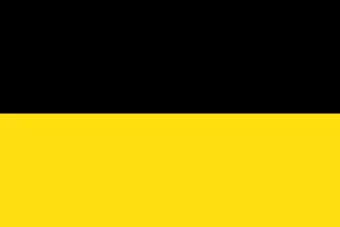 Austrian Empire: Dame of the Order of the Starry Cross
Austrian Empire: Dame of the Order of the Starry Cross Spain: Dame of the Order of Queen Maria Luisa
Spain: Dame of the Order of Queen Maria Luisa.svg.png.webp) Kingdom of Bavaria: Dame of the Order of Saint Elizabeth
Kingdom of Bavaria: Dame of the Order of Saint Elizabeth
Children
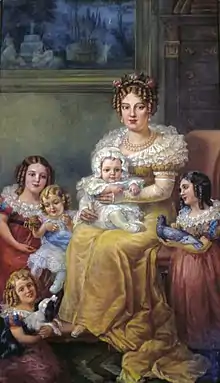
| Name | Portrait | Lifespan | Notes |
|---|---|---|---|
| Maria II of Portugal |  |
4 April 1819 – 15 November 1853 |
Queen of Portugal from 1826 until 1853. Maria II's first husband, Auguste de Beauharnais, 2nd Duke of Leuchtenberg, died a few months after the marriage. Her second husband was Prince Ferdinand of Saxe-Coburg and Gotha, who became King Dom Fernando II after the birth of their first child. She had eleven children from this marriage. Maria II was heiress presumptive to her brother Pedro II as Princess Imperial until her exclusion from the Brazilian line of succession by law no. 91 of 30 October 1835.[11] |
| Miguel, Prince of Beira | 26 April 1820 | Prince of Beira from birth to his death. | |
| João Carlos, Prince of Beira | 6 March 1821 – 4 February 1822 |
Prince of Beira from birth to his death. | |
| Princess Januária of Brazil |  |
11 March 1822 – 13 March 1901 |
Married Prince Luigi, Count of Aquila, son of Don Francesco I, King of the Two Sicilies. She had four children from this marriage. Officially recognized as an Infanta of Portugal on 4 June 1822,[12] she was later considered excluded from the Portuguese line of succession after Brazil became independent.[13] |
| Princess Paula of Brazil | 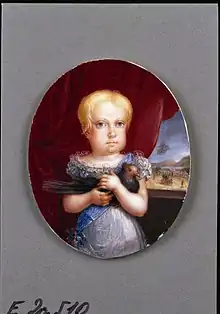 |
17 February 1823 – 16 January 1833 |
She died age 9, probably of meningitis.[14] Born in Brazil after its independence, Paula was excluded from the Portuguese line of succession.[15] |
| Princess Francisca of Brazil | 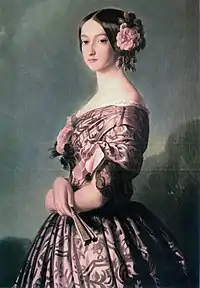 |
2 August 1824 – 27 March 1898 |
Married Prince François, Prince of Joinville, son of Louis Philippe I, King of the French. She had three children from this marriage. Born in Brazil after its independence, Francisca was excluded from the Portuguese line of succession.[16] |
| Pedro II of Brazil | 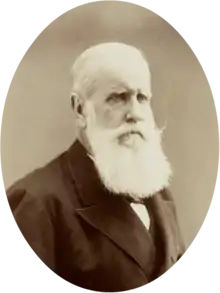 |
2 December 1825 – 5 December 1891 |
Emperor of Brazil from 1831 until 1889. He was married to Teresa Cristina of the Two Sicilies, daughter of Don Francesco I, King of the Two Sicilies. He had four children from this marriage. Born in Brazil after its independence, Pedro II was excluded from the Portuguese line of succession and did not become King Dom Pedro V of Portugal upon his father's abdication.[17] |
Ancestry
| Ancestors of Maria Leopoldina of Austria | |||||||||||||||||||||||||||||||||||||||||||||||||||||||||||||||||||||||||||||||||||||||||||||||||||||||||||||||||||||||||||||||||||||||||||||||||||||||||||||||||||||||||||||||||||||||||||||||||||||||||||||||||||||||||||||||||||||||||||||||||||||||||||||||||||||||||||||||||||||||||
|---|---|---|---|---|---|---|---|---|---|---|---|---|---|---|---|---|---|---|---|---|---|---|---|---|---|---|---|---|---|---|---|---|---|---|---|---|---|---|---|---|---|---|---|---|---|---|---|---|---|---|---|---|---|---|---|---|---|---|---|---|---|---|---|---|---|---|---|---|---|---|---|---|---|---|---|---|---|---|---|---|---|---|---|---|---|---|---|---|---|---|---|---|---|---|---|---|---|---|---|---|---|---|---|---|---|---|---|---|---|---|---|---|---|---|---|---|---|---|---|---|---|---|---|---|---|---|---|---|---|---|---|---|---|---|---|---|---|---|---|---|---|---|---|---|---|---|---|---|---|---|---|---|---|---|---|---|---|---|---|---|---|---|---|---|---|---|---|---|---|---|---|---|---|---|---|---|---|---|---|---|---|---|---|---|---|---|---|---|---|---|---|---|---|---|---|---|---|---|---|---|---|---|---|---|---|---|---|---|---|---|---|---|---|---|---|---|---|---|---|---|---|---|---|---|---|---|---|---|---|---|---|---|---|---|---|---|---|---|---|---|---|---|---|---|---|---|---|---|---|---|---|---|---|---|---|---|---|---|---|---|---|---|---|---|---|---|---|---|---|---|---|---|---|---|---|---|---|---|---|---|---|
| |||||||||||||||||||||||||||||||||||||||||||||||||||||||||||||||||||||||||||||||||||||||||||||||||||||||||||||||||||||||||||||||||||||||||||||||||||||||||||||||||||||||||||||||||||||||||||||||||||||||||||||||||||||||||||||||||||||||||||||||||||||||||||||||||||||||||||||||||||||||||
Depictions in media
Maria Leopoldina was portrayed by Letícia Colin in the 2017 telenovela Novo Mundo.[23]
Footnotes
- Oberacker 1988, p. 31.
- Oberacker 1988, pp. 301–302.
- Schloß Schönbrunn (2010). "Leopoldine: Sunday's child". The World of the Habsburgs. habsburger.net. Archived from the original on February 21, 2013. Retrieved March 9, 2012.
- Schloß Schönbrunn (2010). "1816 – A fateful year for Leopoldine". The World of the Habsburgs. habsburger.net. Archived from the original on July 9, 2012. Retrieved March 9, 2012.
- Schloß Schönbrunn (2010). "An enquiry from Rio de Janeiro". The World of Habsburgs. habsburger.net. Archived from the original on July 15, 2012. Retrieved March 9, 2012.
- Schloß Schönbrunn (2010). "An expedition to the tropics". The World of the Habsburgs. habsburger.net. Archived from the original on December 7, 2011. Retrieved March 9, 2012.
- Schloß Schönbrunn (2010). "A Portuguese fairy-tale prince?". The World of the Habsburgs. habsburger.net. Archived from the original on December 6, 2011. Retrieved March 9, 2012.
- Gloria Kaiser: Dona Leopoldina – Habsburg Princess, Empress of Brazil, 2009, p. 15 [retrieved 14 July 2015].
- Medeiros, Michelle (2012). "Crossing boundaries into a world of scientific discoveries: Maria Graham in nineteenth-century Brazil". Studies in Travel Writing. 16 (3): 263–285. doi:10.1080/13645145.2012.702957. S2CID 143647506.
- Barman 2002, p. 40.
- Barman 1999, p. 438.
- Morato 1835, p. 17.
- Morato 1835, pp. 33–34.
- Barman 1999, p. 42.
- Morato 1835, pp. 17–18.
- Morato 1835, pp. 18–19, 34.
- Calmon 1975, p. 81.
- Wurzbach, Constantin, von, ed. (1861). . Biographisches Lexikon des Kaiserthums Oesterreich [Biographical Encyclopedia of the Austrian Empire] (in German). 7. p. 60 – via Wikisource.
- Wurzbach, Constantin, von, ed. (1860). . Biographisches Lexikon des Kaiserthums Oesterreich [Biographical Encyclopedia of the Austrian Empire] (in German). 6. p. 208 – via Wikisource.
- Wurzbach, Constantin, von, ed. (1861). . Biographisches Lexikon des Kaiserthums Oesterreich [Biographical Encyclopedia of the Austrian Empire] (in German). 7. p. 53 – via Wikisource.
- Genealogie ascendante jusqu'au quatrieme degre inclusivement de tous les Rois et Princes de maisons souveraines de l'Europe actuellement vivans [Genealogy up to the fourth degree inclusive of all the Kings and Princes of sovereign houses of Europe currently living] (in French). Bourdeaux: Frederic Guillaume Birnstiel. 1768. p. 9.
- Wurzbach, Constantin, von, ed. (1861). . Biographisches Lexikon des Kaiserthums Oesterreich [Biographical Encyclopedia of the Austrian Empire] (in German). 7. p. 81 – via Wikisource.
- "'Novo Mundo', nova novela das 6: Letícia Colin será Leopoldina". Gshow (in Portuguese). Retrieved 28 February 2017.
References
- Oberacker, Carlos H. (1988). Leopoldine: Habsburgs Kaiserin von Brasilien (in German). Vienna/Munich: Amalthea. ISBN 3-85002-265-X.
- Barman, Roderick J. (1999). Citizen Emperor: Pedro II and the Making of Brazil, 1825–1891. Stanford, California: Stanford University Press.
- Morato, Francisco de Aragão (1835). Memória sobre a soccessão da coroa de Portugal, no caso de não haver descendentes de Sua Magestade Fidelíssima a rainha D. Maria II (in Portuguese). Lisbon: Typographia de Firmin Didot.
- Calmon, Pedro (1975). História de D. Pedro II (in Portuguese) 1–5. Rio de Janeiro: José Olímpio.
- Medeiros, Michelle. “Crossing boundaris into a world of scientific discoveries: Maria Graham in nineteenth-century Brazil.” Studies in Travel Writing 16, no. 3 (September 2012): 263–285. Accessed March 12, 2020. https://doi.org/10.1080/13645145.2012.702957
External links
| Wikimedia Commons has media related to Maria Leopoldina of Austria. |
- Article by Princess Michael of Kent about Leopoldine Retrieved 26 January 2006
Maria Leopoldina of Austria Cadet branch of the House of Lorraine Born: 22 January 1797 Died: 11 December 1826 | ||
| New title Empire of Brazil established |
Empress consort of Brazil 12 October 1822 – 11 December 1826 |
Vacant Title next held by Amélie of Leuchtenberg |
| Preceded by Carlota Joaquina of Spain |
Queen consort of Portugal 10 March 1826 – 2 May 1826 |
Vacant Title next held by Auguste de Beauharnaisas prince consort |